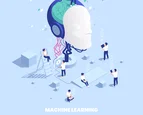1 Opportunistic design of the MLOps pipeline
One of the most costly pitfalls in applying data science actually manifests itself the moment you start it. Not surprisingly, because data science generally starts with small experiments to gain experience. Once the potential is experienced and results are picked up by stakeholders, the temptation is great to continue on the experimental basis. As a result, the organization is not properly prepared for what MLOps is intended to do. Those who neglect the success factors below will put the success of data science at risk in no time.
1a. Clear objectives and strategy
A well-defined strategy and clear objectives define the path that involved departments follow and how those departments contribute to business goals. Start by identifying the specific goals of the MLOps pipeline. What does the company want to achieve with MLOps? Then develop a strategic plan to achieve these goals, which specifically defines how the MLOps pipeline integrates seamlessly with existing business processes. Include the departments that MLOps will first target: the analytics buyer!
1b. Collaboration between teams
In addition to close collaboration with business stakeholders, MLOps requires collaboration between different teams under the hood. This includes the data scientists themselves, as well as the software engineering teams and operational teams, such as IT-administrators, DBAs and application managers. Establish open communication channels between these teams. Without those "short lines," there is no effective collaboration and MLOps will lose performance and quality.
1c. Data management and governance
Ensure that a well-defined data governance strategy is in place to ensure data quality and regulate data access. Implement data catalogs and data line processes to ensure traceability, transparency and quality of source data. In addition to data, proper control of algorithms is critical to the accuracy and reliability of Machine Learning models. A solid data management and governance approach for both data and algorithms, ensures consistency in high-quality insights.
1d. Invest in mature technology in the value chain
Like everywhere else, optimized and scalable infrastructure helps improve performance and reduce costs. In the experimental phase of data science, none of this is important yet, but the moment business operations become dependent on it, it is a different story. Therefore, incrementally, in accordance with the strategic plan, provide a robust and scalable infrastructure to develop, implement and maintain Machine Learning models. Choose tools and technologies that fully support the MLOps pipeline, such as automated data preparation and model deployment, version control, API management and monitoring.
1e. Automated performance monitoring
Monitoring from within the MLOps team itself is crucial for early detection of performance setbacks. Monitoring also allows you to enable teams to intervene proactively, that is, before there are signals from the business that a drop in performance has occurred. However, manual monitoring is costly and mind-numbing work, which can put it at the bottom of the to-do list. So automate robust automated monitoring mechanisms to track model performance in production and respond to model degradation in a timely manner, without sacrificing development work.



